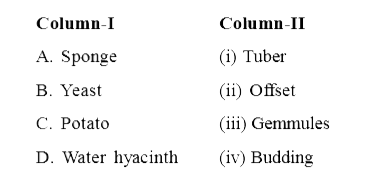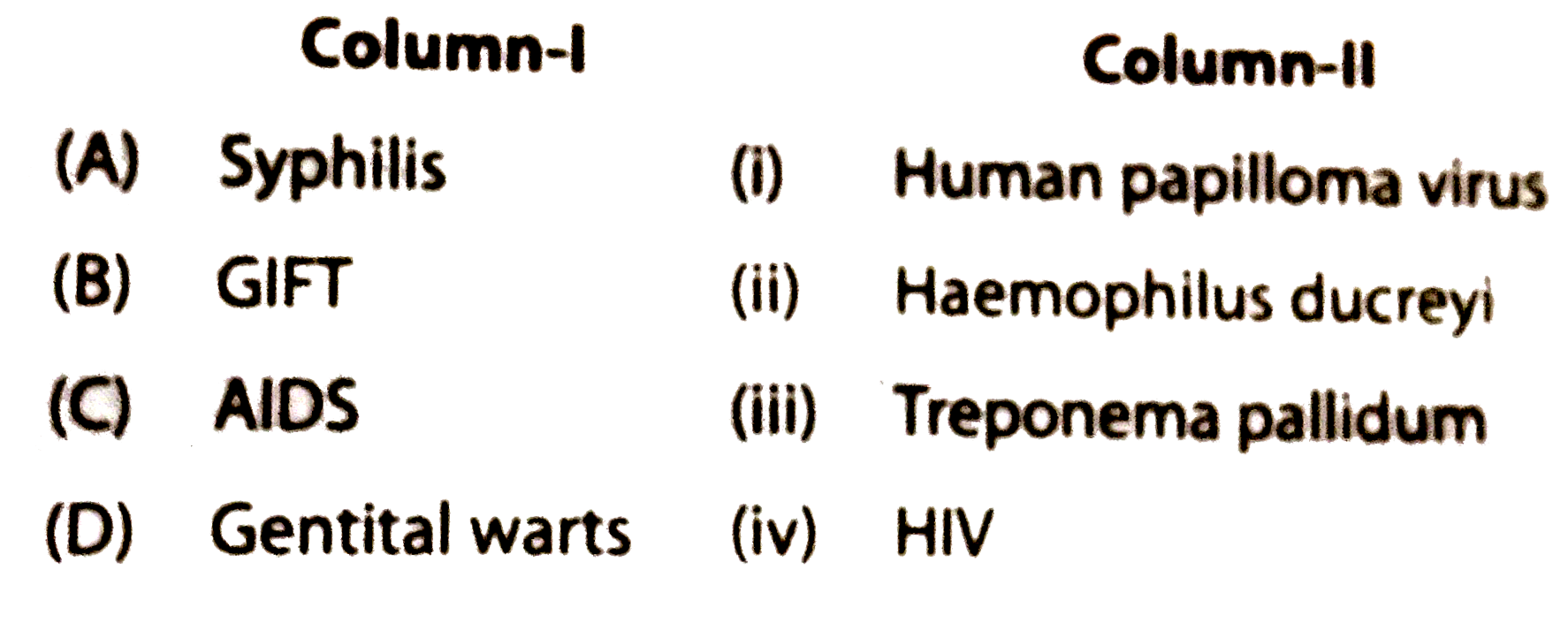Match Column - I and Column - II and select the correct option from the codes given below.
(Types of synovial joint) (A)Ball and socket (B)Hinge (C)Pivot (D)Saddle
(Bones involved) (i)Carpal and metacarpal of thumb (ii)Atlas and axis (iii)Frontal and parietal (iv)Knee (v)Humerus and pectoral girdle
A-(v),B-(iv),C-(ii),D-(i)
A-(i),B-(iii),C-(iv),D-(v)
A-(v),B-(iv),C-(iii),D-(i)
A-(i),B-(ii),C-(v),D-(iv)
The correct Answer is:A
To solve the matching question regarding types of synovial joints and the bones involved, we will follow these steps:
1. Identify the Types of Synovial Joints:
- We have four types of synovial joints listed:
- (A) Ball and socket
- (B) Hinge
- (C) Pivot
- (D) Saddle
2. Identify the Bones Involved:
- The bones involved are:
- (i) Carpal and metacarpal of thumb
- (ii) Atlas and axis
- (iii) Frontal and parietal
- (iv) Knee
- (v) Humerus and pectoral girdle
3. Match Each Joint Type with the Correct Bones:
- (A) Ball and socket: This joint allows for a wide range of movement and is found between the humerus and the pectoral girdle (shoulder joint). Thus, it matches with (v).
- (B) Hinge: This joint allows movement in one direction, like the knee joint. Therefore, it matches with (iv).
- (C) Pivot: This joint allows for rotational movement and is found between the atlas and axis (first and second cervical vertebrae). So, it matches with (ii).
- (D) Saddle: This joint allows for movement in two planes and is found between the carpal and metacarpal of the thumb. Thus, it matches with (i).
4. Summarize the Matches:
- (A) Ball and socket → (v) Humerus and pectoral girdle
- (B) Hinge → (iv) Knee
- (C) Pivot → (ii) Atlas and axis
- (D) Saddle → (i) Carpal and metacarpal of thumb
5. Select the Correct Option:
- Based on the matches:
- A → v
- B → iv
- C → ii
- D → i
- The correct option from the codes given is the first option.
Final Answer:
The correct matches are:
- (A) → (v)
- (B) → (iv)
- (C) → (ii)
- (D) → (i)
Thus, the answer is Option 1.
- We have four types of synovial joints listed:
- (A) Ball and socket
- (B) Hinge
- (C) Pivot
- (D) Saddle
- The bones involved are:
- (i) Carpal and metacarpal of thumb
- (ii) Atlas and axis
- (iii) Frontal and parietal
- (iv) Knee
- (v) Humerus and pectoral girdle
- (A) Ball and socket: This joint allows for a wide range of movement and is found between the humerus and the pectoral girdle (shoulder joint). Thus, it matches with (v).
- (B) Hinge: This joint allows movement in one direction, like the knee joint. Therefore, it matches with (iv).
- (C) Pivot: This joint allows for rotational movement and is found between the atlas and axis (first and second cervical vertebrae). So, it matches with (ii).
- (D) Saddle: This joint allows for movement in two planes and is found between the carpal and metacarpal of the thumb. Thus, it matches with (i).
- (A) Ball and socket → (v) Humerus and pectoral girdle
- (B) Hinge → (iv) Knee
- (C) Pivot → (ii) Atlas and axis
- (D) Saddle → (i) Carpal and metacarpal of thumb
- Based on the matches:
- A → v
- B → iv
- C → ii
- D → i
- The correct option from the codes given is the first option.
The correct matches are:
- (A) → (v)
- (B) → (iv)
- (C) → (ii)
- (D) → (i)
Similar Questions
Knowledge Check
- Question 1 - Select One
Match Column -I with Column -II and select the correct option from the codes given below.
 AA - (i), B - (ii), C-(iii), D - (iv)BA - (iv), B - (i), C-(ii), D- (iii)CA - (iv), B - (iii), C-(ii), D- (i)DA - (iii), B - (iv), C-(i), D - (ii)
AA - (i), B - (ii), C-(iii), D - (iv)BA - (iv), B - (i), C-(ii), D- (iii)CA - (iv), B - (iii), C-(ii), D- (i)DA - (iii), B - (iv), C-(i), D - (ii) - Question 2 - Select One
Match Column I with Column II and select the correct option from the codes given below.
 AA-(i), B-(ii), C-(iii), D-(iv)BA-(ii), B-(iii), C-(iv), D-(i)CA-(ii), B-(iv), C-(iii), D-(i)DA-(iv), B-(iii), C-(ii), D-(i)
AA-(i), B-(ii), C-(iii), D-(iv)BA-(ii), B-(iii), C-(iv), D-(i)CA-(ii), B-(iv), C-(iii), D-(i)DA-(iv), B-(iii), C-(ii), D-(i) - Question 3 - Select One
Match Column I with Column II and select the correct option from the codes given below.
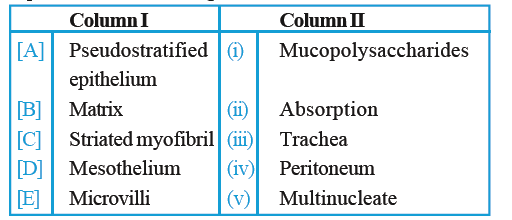 AA - (i), B - (ii), C-(iii), D - (iv)BA - (iv), B - (i), C-(ii), D- (iii)CA - (iv), B - (iii), C-(ii), D- (i)DA - (iii), B - (iv), C-(i), D - (ii)
AA - (i), B - (ii), C-(iii), D - (iv)BA - (iv), B - (i), C-(ii), D- (iii)CA - (iv), B - (iii), C-(ii), D- (i)DA - (iii), B - (iv), C-(i), D - (ii)
Match Column I with column II and select the correct option from the codes given below:
 View Solution
View SolutionMatch Column I with column II and select the correct option from the codes given below:
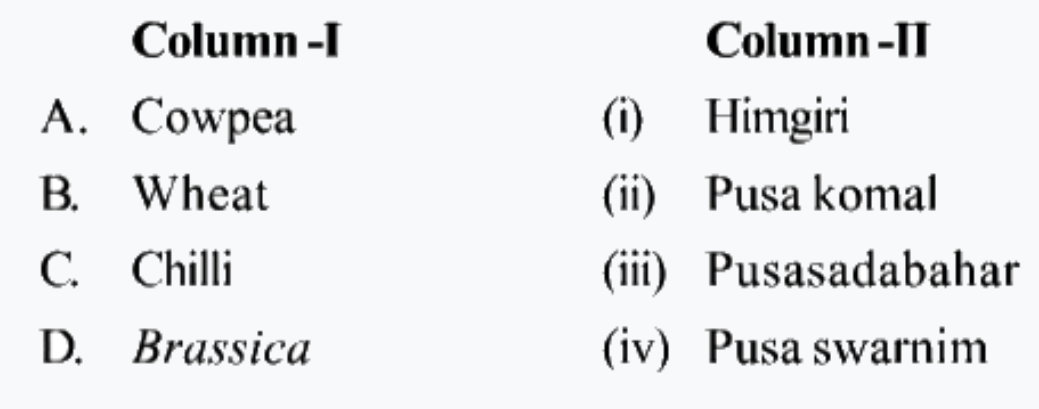 View Solution
View SolutionMatch Column I with column II and select the correct option from the codes given below:
 View Solution
View SolutionMatch the Column I with Column II and select the correct option from the codes given below.
 View Solution
View SolutionMatch the Column I with Column II and select the correct option from the codes given below.
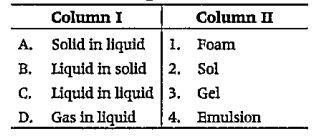 View Solution
View Solution


